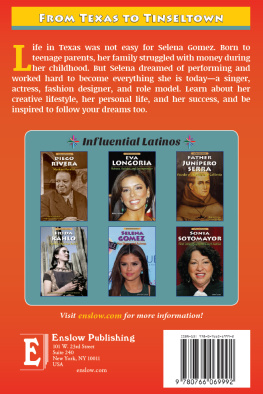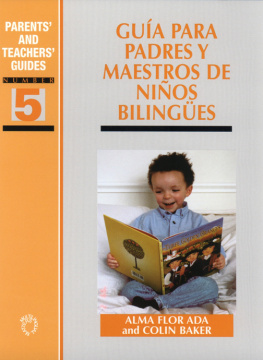Joe Nick Patoski - Selena: Como La Flor
Here you can read online Joe Nick Patoski - Selena: Como La Flor full text of the book (entire story) in english for free. Download pdf and epub, get meaning, cover and reviews about this ebook. year: 1996, publisher: Little, Brown, genre: Non-fiction. Description of the work, (preface) as well as reviews are available. Best literature library LitArk.com created for fans of good reading and offers a wide selection of genres:
Romance novel
Science fiction
Adventure
Detective
Science
History
Home and family
Prose
Art
Politics
Computer
Non-fiction
Religion
Business
Children
Humor
Choose a favorite category and find really read worthwhile books. Enjoy immersion in the world of imagination, feel the emotions of the characters or learn something new for yourself, make an fascinating discovery.

- Book:Selena: Como La Flor
- Author:
- Publisher:Little, Brown
- Genre:
- Year:1996
- Rating:4 / 5
- Favourites:Add to favourites
- Your mark:
- 80
- 1
- 2
- 3
- 4
- 5
Selena: Como La Flor: summary, description and annotation
We offer to read an annotation, description, summary or preface (depends on what the author of the book "Selena: Como La Flor" wrote himself). If you haven't found the necessary information about the book — write in the comments, we will try to find it.
Selena: Como La Flor — read online for free the complete book (whole text) full work
Below is the text of the book, divided by pages. System saving the place of the last page read, allows you to conveniently read the book "Selena: Como La Flor" online for free, without having to search again every time where you left off. Put a bookmark, and you can go to the page where you finished reading at any time.
Font size:
Interval:
Bookmark:

Also by Joe Nick Patoski
Stevie Ray Vaughan: Caught in the Crossfire (with Bill Crawford)
COMO
LA
FLOR
Joe Nick Patoski
Copyright 2018 Joe Nick Patoski
Copyright 1996 by Joe Nick Patoski
All rights reserved. No part of this book may be reproduced in any form or by any electronic or mechanical means, including information storage and retrieval systems, without permission in writing from the publisher, except by a reviewer who may quote brief passages in a review.
First Edition
The author is grateful for permission to include the following previously copyrighted material: Excerpts from letters in Brazosport Facts and The Corpus Christi Times. Copyright 1995.
Reprinted by permission of The Corpus Christi Times.
Library of Congress Cataloging-in-Publication Data
Patoski, Joe Nick.
Selena: como la flor/Joe Nick Patoski.
p. cm.
Discography:
Includes bibliographical references.
ISBN 0-316-69378-2
1. Selena, 1971-1995. 2. Tejano musiciansBiography. I. Tide.
ML420.S458P37 1996
782.42164dc20
[B] 95-51815
10 9 8 7 6 5 4 3 2 1
MV-NY
Published simultaneously in Canada by Little, Brown & Company (Canada) Limited
Printed in the United States of America
To Johnny and Henry Molina, wherever you are
T O most of the diners enjoying their chicken flautas at Papa Gayos, in Lake Jackson, Texas, the sweet little girl with the bubbly personality was part of the Mexican restaurants entertainment. Papa Gayos was a family operation, and everyone involved mom, dad, the kids, the relatives played a role. The little girls older brother, A.B., had sanded the tables, her father built the stage, and the little girl, along with A.B. and her sister Suzette, kept everyone amused and entertained.
She stepped up to the microphone tentatively, but once the music started she appeared poised and confident, as if she had been doing this all her life. On cue, she took a deep breath, and then belted out the lines shed rehearsed:
Feeeee-lings, whoa-ohhhhh-ahhhhh, feeeee-lings...
She sang as if the hurt described in the songs lyrics was a hurt shed felt. Then she sneaked a glance at the man watching her from the side of the stage, waiting for his lips to reveal the slightest hint of an approving smile.
The little girls name was Selena, and even a stranger could tell she was her fathers pride and joy. Behind her, standing only a few feet away on the same stage, her brother and sister played bass and drums in accompaniment. But it was the little girls booming voice, big and brassy, emotive and evocative, that grabbed diners attention. Even the mayor, the city manager, and their wives, who were dining together at one table, paused between bites to marvel over the little girls talent. She played to the restaurants customers as if they were a crowd of thousands in a concert hall.
The little girls father, Abraham Quintanilla, had raised her to do just that. Long ago, before anyone else had an inkling of her ability, he believed his little girl possessed a talent, the special something that separated stars from almost-stars like him. It was in her blood.
The restaurants specialty, Mexican food, was part of the familys heritage. The little girls mother, Marcella, a sweet, shy lady with an attractive, perennially youthful face, came from Washington State. But like her husband, Abraham, who was born and raised in South Texas, she could trace her roots back to Mexico. Washington harbored many families like Marcella Samoras, people who settled there as part of the mass migration of farm workers from the south. The Quintanilla side of the family could also trace its roots back to the migrants who had crossed the Rio Grande to pick cotton, vegetables, and fruits; they later settled in Corpus Christi, where Abraham, Sr., and his wife, Mary, raised Abraham and his six siblings. Eleven years before the restaurant opened, Abraham had followed the elder Quintanilla to the Brazosport area of Texas, where most of his family was already living.
Though the town of Lake Jackson, where the Quintanillas lived, was two hundred miles from Corpus, it felt a million miles away from there, and at least two million from the Rio Grande, the border separating Texas from Mexico. Abraham and Marcella adopted a thoroughly modern, wholly American outlook on life, working hard, raising their children with a firm hand and strict discipline, and striving for a comfortable lifestyle. Early on, the children were taught to speak English, both at home and at school. It was the best way to get ahead in the world. Abraham had learned that the hard way: students caught speaking Spanish in Corpus Christi schools when he was a boy were sent to the principals office and whipped or suspended.
Abraham, his wife and children, and his parents and his brothers and sisters could be identified as Mexicanos by the way they looked and spoke. But having to adapt and assimilate was nothing new to them or people like them; Mexicans in Texas had been adapting and assimilating since before Texas was a state. Lake Jackson was a relatively easy adjustment, even if the population of twenty thousand was ninety percent gabacho. At least it wasnt as bad as some of the neighboring communities whose citizens did not welcome people of Mexican heritage and were often downright hostile.
Abraham, Jr., came to the area to be near his parents and his siblings, but it was Dow Chemical, Lake Jacksons major employer, that kept him there, giving him a steady income that paid for a down payment on a house, material goods, and, ultimately, a piece of Papa Gayos.
Still, no matter how well he and his family fit in, there were always reminders that Abraham was different from most other workers at Dow, whether it was his deep brown skin tone, his prominent nose and chiseled features, or his deep sense of heritage and place. Anglos and Mexicanos shopped side by side at the same stores, ate at the same restaurants, sat next to each other in the movie theaters, and attended the same schools. But at home, they had different value systems and rules, some of which might have struck each other as strange and exotic. The stereotypical Mexicano had a tight-knit extended family, was overly superstitious, Catholic, and spoke only Spanish. The stereotypical Anglo was uptight, the product of a broken home, fundamentalist Christian, and spoke only English. In truth, neither ethnic group fit the stereotype.
The food at Papa Gayos was the most basic link between the two cultures. For most Anglos, Mexican food was the gateway to appreciating Texass Other Society. The ingredients peppers, onions, garlic, cilantro, comino were Mexican in origin but there were not-so-subtle variations that were distinctly Texan (or Tejano, as the Mexicanos often referred to themselves): in the arroz con polio (rice with chicken), carne guisada (stew), and chile rellenos (stuffed chili peppers), the cheese was yellow instead of white, and less cilantro and serranos and more jalapenos, comino, and chili powder common in the Mexican interior were used. The dishes were accompanied by handmade flour tortillas instead of the corn variety served in Mexico. In the company of a gleaming mound of beans refried in lard and rice and spiced by a red salsa, the creations were uniquely Tex-Mex.
The implications made little sense to the nine-year-old Selena, raised to sing pop and country songs and the occasional traditional Mexican song to please her father, her family, and the diners. Music transcended cultural differences. Music, and plenty of practice, as she would later reflect. My dad had this old songbook, and I picked it up and I started making my own melodies. He heard me one day and he started saying, No, do it like this. He was teaching me the melodies and I caught on pretty fast.
Font size:
Interval:
Bookmark:
Similar books «Selena: Como La Flor»
Look at similar books to Selena: Como La Flor. We have selected literature similar in name and meaning in the hope of providing readers with more options to find new, interesting, not yet read works.
Discussion, reviews of the book Selena: Como La Flor and just readers' own opinions. Leave your comments, write what you think about the work, its meaning or the main characters. Specify what exactly you liked and what you didn't like, and why you think so.









